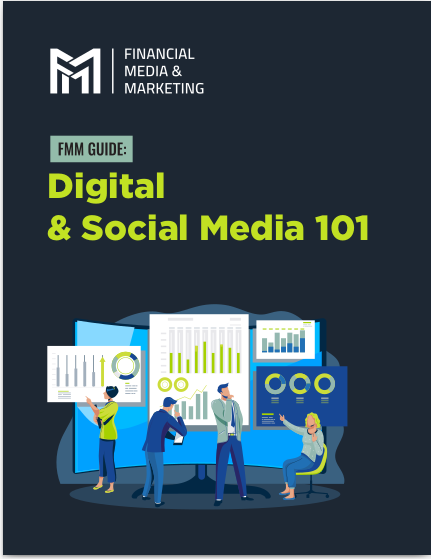Key Takeaways:
-
An optimized digital presence ensures that every online interaction builds trust, enhances credibility, and connects you with potential clients.
-
Consistent branding and a user-friendly approach make your online platforms a valuable resource for your audience.
Why Your Digital Presence Matters More Than Ever
As a financial advisor, your digital presence is often the first impression potential clients have of you. Whether they’re finding you through a Google search, social media, or your website, what they see will determine if they take the next step. A weak or inconsistent online presence can undermine your credibility, while an optimized one positions you as a professional they can trust.
Your online platforms aren’t just about being visible; they’re about creating value for every visitor. From delivering insightful content to providing easy ways to connect, a well-optimized digital presence helps build stronger client relationships and drives engagement. Here’s how to ensure your efforts hit the mark.
Step 1: Audit Your Current Online Presence
Before you make improvements, you need to know where you stand. Conducting a digital audit helps you identify strengths, weaknesses, and opportunities for growth. Here’s what to focus on:
-
Website Performance: Is your site easy to navigate? Does it load quickly? Review metrics like bounce rate and average time on page to assess user engagement.
-
Social Media Profiles: Are they up-to-date and aligned with your brand? Check for consistency in visuals, tone, and messaging.
-
Search Engine Visibility: Are potential clients finding you easily? Use tools to evaluate your rankings for relevant keywords.
-
Mobile Friendliness: With most users browsing on their phones, ensure your platforms look great and function well on smaller screens.
An audit sets the foundation for targeted improvements, allowing you to focus on areas that matter most to your audience.
Step 2: Create a Cohesive Brand Identity
Your brand is more than a logo or color scheme—it’s the personality and values your audience associates with you. A consistent brand identity builds trust and makes your digital presence more memorable. Here’s how to establish one:
-
Define Your Core Message: What do you want clients to know about you? Whether it’s your expertise, transparency, or client-first approach, make sure it’s clear across all platforms.
-
Maintain Visual Consistency: Use the same logo, fonts, and color palette across your website, social media, and marketing materials.
-
Adopt a Consistent Tone: Decide whether your voice is formal, conversational, or somewhere in between, and stick with it in all communications.
By aligning every aspect of your online presence with your brand, you’ll create a seamless experience for clients and leads.
Step 3: Optimize Your Website for Engagement
Your website is the cornerstone of your digital presence. It should do more than provide information—it should engage visitors and guide them toward taking action. Here’s how to optimize it:
-
Simplify Navigation: Make it easy for users to find what they’re looking for with clear menus and intuitive layouts.
-
Create Valuable Content: Publish blogs, articles, or resources that address common financial questions and challenges.
-
Include Strong CTAs: Encourage visitors to book a consultation, subscribe to your newsletter, or download a helpful guide.
-
Highlight Testimonials: Showcase client feedback to build trust and credibility.
A user-friendly website leaves a positive impression and increases the likelihood that visitors will engage with your services.
Step 4: Build Authority Through Content
Content marketing is a powerful way to position yourself as an expert in your field. By sharing knowledge, you demonstrate your value and keep your audience coming back for more. Here’s how to create impactful content:
-
Focus on Client Needs: Address topics that matter to your audience, such as retirement planning, tax strategies, or financial literacy.
-
Be Consistent: Aim for regular updates, whether it’s weekly blog posts, monthly newsletters, or quarterly webinars.
-
Use Different Formats: Mix it up with articles, videos, infographics, and podcasts to cater to various preferences.
Valuable content not only builds your credibility but also enhances your search engine rankings, making it easier for potential clients to find you.
Step 5: Leverage Social Media to Connect
Social media platforms are excellent tools for building relationships and reaching a broader audience. To use them effectively, follow these guidelines:
-
Choose the Right Platforms: Focus on platforms where your target audience is most active, such as LinkedIn for professionals or Instagram for younger demographics.
-
Engage Actively: Respond to comments, share relevant content, and participate in discussions to build a sense of community.
-
Post Strategically: Share a mix of educational content, client success stories, and industry updates to keep your audience engaged.
Social media allows you to showcase your expertise while fostering connections that can lead to new opportunities.
Step 6: Prioritize Search Engine Optimization (SEO)
SEO ensures your digital presence is discoverable by potential clients searching for financial advice. Optimizing for search engines can drive more traffic to your website and increase your visibility. Here’s how to get started:
-
Use Relevant Keywords: Identify terms your audience is searching for, such as “retirement planning tips” or “financial advisor near me.”
-
Optimize On-Page Elements: Include keywords in your titles, headings, and meta descriptions.
-
Build Quality Backlinks: Partner with reputable websites to link back to your content.
-
Ensure Mobile Optimization: Search engines prioritize mobile-friendly sites, so make sure yours performs well on all devices.
SEO is a long-term strategy, but the results are worth the effort. Higher rankings mean more organic traffic and better exposure for your brand.
Step 7: Use Analytics to Track Performance
Data-driven decisions are key to optimizing your digital presence. Regularly reviewing analytics helps you understand what’s working and what needs adjustment. Focus on these metrics:
-
Website Traffic: Monitor the number of visitors and identify which pages are most popular.
-
Engagement Rates: Track how users interact with your content, such as time spent on pages or shares on social media.
-
Conversion Rates: Measure how many visitors take desired actions, like signing up for your newsletter or booking a consultation.
With these insights, you can refine your strategies to better meet your audience’s needs.
Step 8: Ensure Accessibility and Inclusivity
A truly optimized digital presence is one that’s accessible to everyone. By making your platforms inclusive, you’ll reach a broader audience and demonstrate your commitment to serving all clients. Here’s what to consider:
-
Use Clear Text and Large Fonts: Ensure your content is easy to read, especially for users with visual impairments.
-
Provide Alt Text for Images: Describe images for those using screen readers.
-
Test for Compatibility: Make sure your website works seamlessly with assistive technologies.
Accessibility isn’t just a best practice—it’s essential for creating a welcoming and professional online presence.
Step 9: Build Trust Through Reviews and Testimonials
Online reviews and testimonials are among the most persuasive tools you have for building trust. Encourage satisfied clients to share their experiences on platforms like Google or your website. When showcasing reviews:
-
Highlight Specific Benefits: Focus on how your services addressed client pain points or delivered results.
-
Update Regularly: Keep testimonials fresh by adding new ones periodically.
-
Respond to Feedback: Engage with reviews, thanking clients for positive feedback and addressing any concerns professionally.
A strong portfolio of reviews boosts your credibility and helps potential clients feel confident in choosing you.
Maximize Every Click for Long-Term Success
Optimizing your digital presence is an ongoing process that requires consistency, creativity, and attention to detail. By auditing your current platforms, creating valuable content, and prioritizing engagement, you can ensure every click and interaction adds value to your brand. The result? Stronger connections with your audience and greater opportunities to grow your financial advisory practice.










